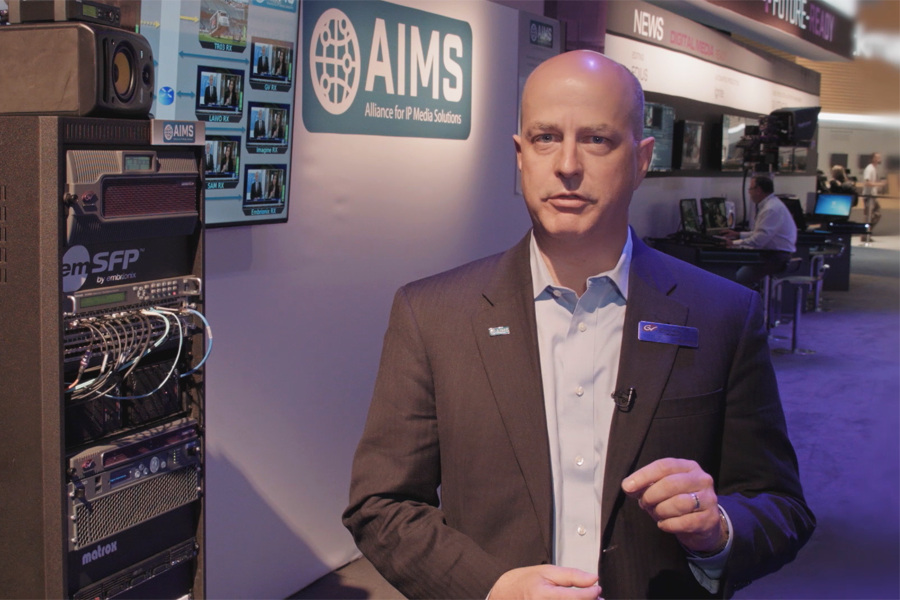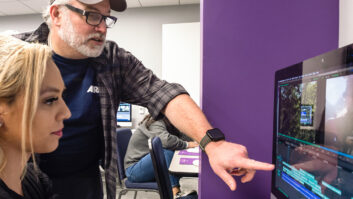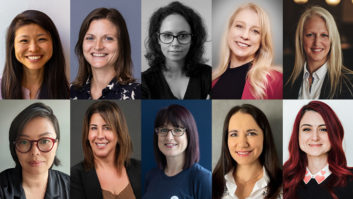
A little less than six months since its formation was announced, AIMS already has the appearance of being a major industry player. Established to promote the adoption of standards that facilitate the shift from legacy SDI systems to IP-based operations, among them VSF TR-03 and TR-04, SMPTE 2022-6 and AES67, the organisation has grown rapidly in both stature and size. At the time of writing, it has 21 full members listed on its website – ranging from leading vendors such as Grass Valley, Evertz, Lawo and Sony, to content producers including 21st Century Fox – as well as 11 associate members.
The vision outlined by chairman Michael Cronk (who is also vice president of core technology at Grass Valley) is one of an organisation that “sits beneath” other industry groups in supporting what is surely one of the most significant transitions broadcasters have ever faced, and which also zeroes in on the reasons for, and benefits of, audio vendor involvement.
AIMS enjoyed a high profile at NAB, so how would you characterise the current state of its progress?
In less than half a year we have gathered more than 30 members, including some of the main vendors in the industry, as well as broadcasters, service providers and systems integrators; so on a membership level, I think the progress made has been fantastic. [In particular] I think the project has assisted in generating momentum for a standards-based approach; I am sure it was latent in the industry [previously], but AIMS has helped bring it to the forefront.
Do you think the main objectives of the Alliance have been successfully communicated to the industry as a whole?
I think the goals we have are clear, but with anything like this there is a constant need to communicate. There are a great number of organisations out there – such as the VSF, EBU, SMPTE and so on – and it is entirely logical for people to ask what roles they have, and whether they are competing with each other or working together. Hence, at NAB we had a press conference with multiple organisations on the podium, and we have done – and will continue to do – a lot of communication about the fact that there is a synergistic type of relationship [between the various groups]. There is a common goal and that is interoperability.
But one thing I would stress is that there is still a lot of confusion around the issue of ‘what is a standard’; there is a tendency for people to throw that word around a lot. So education is a key thing in that regard and it’s a job that is never really done.
It can be argued that audio is somewhat further down the road when it comes to IP, and that is a sector in which there are already plenty of organisations supporting the transition, so what are the benefits of joining AIMS for companies in that space?
That’s a great question, and in fact I think that in some ways, audio leads video in terms of the adoption of various technologies [and as a result] there is a lot the broadcast world can learn from the audio community. At the moment, we see that the broadcast community is adopting [audio-over-IP interoperability standard] AES67, and one of the aspects we are working on is determining which are the right operating points in the broadcast workflow within AES67. It should be noted, though, that there are things that AES67 does not cover – for example, discovery and registration, and connection management – so there are several pieces of the puzzle that will need to be addressed.
But you definitely see AES67 as being a crucial component of broadcast’s overall IP future?
Absolutely – it is written in stone in our roadmap. Of course we are also supporting the adoption of SMPTE 2022-6, which talks about a rasterisation of SDI; SDI has embedded audio. One of our key priorities will be to work with the standards bodies to talk about how we work, not just with uncompressed audio, but also how we deal with compressed audio within the IP domain.
We are very fortunate that we already have three members with strong audio heritages – Lawo, the Telos Alliance and Avid – although of course we welcome more to join!
Finally, the million-dollar question. With NAB awash with IP-based solutions, and momentum behind the transition seeming to grow all the time, how long do you think it will be before we can write the obituary for SDI?
Oh, that’s a long way off yet. Just look at the move from SD to HD and how long that took, and the fact that there is still plenty of SD usage. The same can be said of analogue. As ever, the nature of the industry is that people have to invest a lot of capital and expect that investment to turn around. They have to go through a lot of investment cycles before they can be said to have refreshed everything [in their technological infrastructure]. So I think, in truth, it will be a long time before SDI disappears, and I am sure in ten years’ time you will be able to walk into most facilities in the world and find SDI there somewhere.
But in the meantime, there is a great deal that we can do to promote the benefits of IP for users – notably agility, flexibility, cable reduction and remote production opportunities – as well as the new business opportunities that it opens up for the industry.







